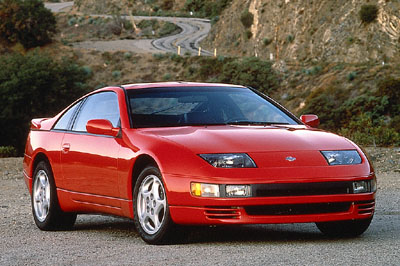
Nissan 300ZX
| Manufacturer | Nissan |
|---|---|
| Also called | Nissan Fairlady Z |
| Production | 1983–2000 (Imports to North America ceased in 1996) |
| Assembly | Hiratsuka, Kanagawa, Japan |
| Predecessor | Nissan 280ZX |
| Successor | Nissan 350Z |
| Class | Sports car/ Grand Tourer |
| Layout | FR layout |
| Transmission(s) | 5-speed manual 4-speed automatic |
The Nissan 300ZX (called the Fairlady Z in Japan) is a sports car that was produced by Nissan. It comprises the third and fourth generations of the Z-car line-up, respectively given the chassis designations Z31 and Z32.
The 300ZX name followed the numerical convention initiated with the 240Z, put forth by Yutaka Katayama, the one time president of Nissan Motors USA. The "X" was added to the model name by its predecessor signifying "luxury". The name was used in most markets with the exception of a few including the Japanese home market, there the car like all previous Z cars was sold as a "Fairlady Z". The best selling 300ZX's were the Z31s, with over 100,000 more sales than the Z32.
The Z31 and Z32 feature a 3.0 litre, V6 naturally-aspirated and single (Z31) or twin (Z32) turbocharged engine. Although both motors are from the same VG series and have the same displacement, the output of the Z32's VG30DE and VG30DETT is greater than the Z31. The VG30DE series also has a double overhead cam and variable valve timing while the older VG30 is a single overhead cam design. The naturally-aspirated Z32 has 222 hp (166 kW) and 198 lb ft (268 N m) of torque versus the Z31 with 160-165 hp and 174 lb ft (236 N m) of torque. Similarly, the twin-turbo Z32s have 300 hp (220 kW) and 283 lb ft (384 N m) torque versus the single turbo Z31, which has 200-205 hp and 227 lb ft (308 N m) of torque. The Z32's twin turbo motor is also intercooled unlike the z31 turbo. The Z31's single overhead cam engine has 13 head bolts per head, for a total of 26, where as the Z32's dual overhead cam engine only has 8 head bolts per head, for a total of 16.
The Z31 chassis was designed after the previous Z-car, the Nissan 280ZX, and had two special editions based on it. The 50th Anniversary Edition focused on luxury to celebrate the company's semi-centennial in 1984, while the Shiro Special, released 4 years later, boasted performance-oriented upgrades.Styling would be completely redesigned with the release of the Z32, tending towards a wider footprint and more rounded curves with an overall result that the Z32 turned in a drag coefficient of .31 compared to the early Z31's .30. The newer chassis also featured hydraulic rear wheel steering called HICAS (in 1994 changed to an electric actuator called SuperHICAS), in its top-of-the-line models. Although it was not a special edition, in 1996 Nissan designated the final 300 American units the Commemorative Edition. Production of the Z32 ceased outside of the home market and continued in Japan until August 2000.